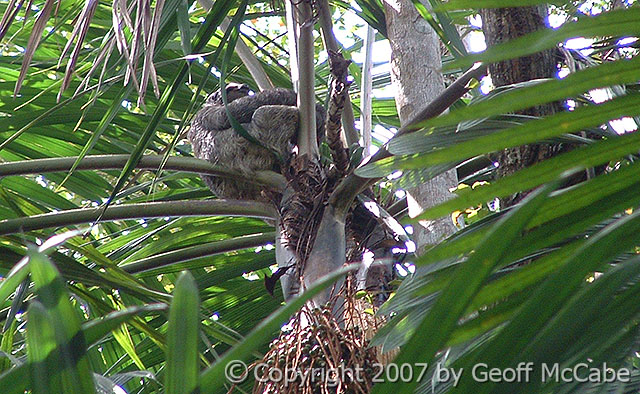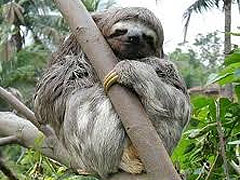- Home
- Accommodation
- Activities
- Area Info
- Maps
- Photo Galleries
- Real Estate
- Travel
Sloth
Height/Weight: Three-toed sloths are about the size of a small dog or a large cat, with the head and body having a combined length of around 45 cm (18 in) and a weight of 3.5–4.5 kg (8–10 lb)
Life Span: About 25-30 years.
Habitat: Found in the trees of South and Central America. Now virtually extinct in Costa Rica.
The sloths are arboreal mammals, and the three-toed sloth is a light weight species that is found mainly on treetops and is not a nocturnal creature like other sloths. Their gut makes up for nearly 30% of their body weight. Sloths eat a significant amount of leaves in the forest. They display slow metabolism and have thick fur to insulate their bodies when the temperature varies through the day and night.
 The three-toed sloth has long rough hair over a dense underfur coat, a white face with a brown stripe on each side, a brown neck, and a body that is brown to yellowish in color. Each adult male has a unique pattern of yellow hair on its back with a black stripe running through the center. Like the name goes, the three-toed has three toes on each of its front and hind feet.
The three-toed sloth has long rough hair over a dense underfur coat, a white face with a brown stripe on each side, a brown neck, and a body that is brown to yellowish in color. Each adult male has a unique pattern of yellow hair on its back with a black stripe running through the center. Like the name goes, the three-toed has three toes on each of its front and hind feet.
The three-toed sloth is active during the day, unlike its nocturnal counterpart the two toed sloth, and is hence spotted more often than the latter. This sloth only eats leaves from trees but may feed on fifty individual trees of up to thirty species, consuming leaves. Sloths live, feed, mate, and reproduce on the elevated levels of the forest canopy. They move to a new tree often enough to consume a balanced diet. The home ranges of different sloths may overlap considerably and females display more social behavior than males, but usually one adult female will occupy the tree with her infant. Sloths will feed on different sources of food depending on what their mothers taught them to eat.
 An adult female spends half the year in the gestation period and the other half rearing her offspring. By two weeks the baby sloths are capable of eating leaves. The mother painstakingly trains the infants about the kind of leaves that are fit for their consumption within their immediate habitat. At 6 months, the mother abandons the baby in her home range and moves to another range in the vicinity. The communication between the infant and the mother stays with the duo communicating through vocalizations. The infant stays in the mother’s former range for a while and then moves away.
An adult female spends half the year in the gestation period and the other half rearing her offspring. By two weeks the baby sloths are capable of eating leaves. The mother painstakingly trains the infants about the kind of leaves that are fit for their consumption within their immediate habitat. At 6 months, the mother abandons the baby in her home range and moves to another range in the vicinity. The communication between the infant and the mother stays with the duo communicating through vocalizations. The infant stays in the mother’s former range for a while and then moves away.
The three toed sloth is virtually extinct in Costa Rica though there is a possibility a few members of the species may still exist is some parts of the country. They have been spotted in Delicias and near the Playa las Manchas in the last few years.
Once a week, the sloth will come down from its elevated habitat, dig a small hole with its stout tail, defecate and urinate inside the hole, then cover it with leaves using its legs and return to its lofty home. This weekly ritual lasts for about half an hour, but the sloth becomes the target of attack during this weekly practice. The mortality of young sloths is abysmally high while those that live to become adults go on to suffer low mortality. These mammals are known to live as long as a decade, with some even surviving for 2-3 decades in the wild.
Further Reading
http://www.infocostarica.com/fauna/3sloth.html
http://costarica.com/wildlife/sloths/
http://www.sibutourscostarica.com/2013/wildlife-in-costa-rica-three-toed-sloth/
Great Stuff

Clandestina Restaurant
My new favorite restaurant, Clandestina is not to be missed by food lovers staying anywhere near to Montezuma. Established in March 2015, Clandestina is the new kid on the block. The Oregon/Tico collaboration is a winner among locals and travelers alike, with artisan craft beers, made onsite by Butterfly Brewing Co. and delicious, exciting […]











